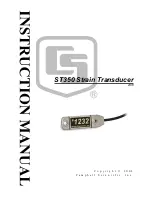
26
57-642 ECLIPSE Model 705 Guided Wave Radar Transmitter for Hygienic Industries
3.2
Theory of Operation
3.2.1 Micropower Impulse Radar
MIR (Micropower Impulse Radar) combines TDR (time
domain reflectometry), ETS (equivalent time sampling) and
modern low power circuitry. This synthesis of technologies
brings to the level market a high-speed radar circuit (speed of
light transmission) at a small fraction of the cost of conven-
tional radar. The electromagnetic pulses are propagated via a
waveguide that yields a system many times more efficient
than through-air radar.
Refer to Appendix A for information concerning the
extremely low level GWR emitted energy into the process.
3.2.2 Time Domain Reflectometry (TDR)
TDR uses pulses of electromagnetic (EM) energy to mea-
sure distances or levels. When a pulse reaches a dielectric
discontinuity (created by media surface), part of the energy
is reflected. The greater the dielectric difference, the greater
the amplitude (strength) of the reflection.
Although TDR is new to the industrial level measurement
industry, it has been used in the telephone, computer, and
power transmission industries for years. In these industries,
it is used to successfully find wire or cable breaks and
shorts. An EM pulse is sent through the wire, traveling
unimpeded until it finds a line break or short. A reflection
is then returned from the break enabling a timing circuit to
pinpoint the location.
In the ECLIPSE transmitter, a waveguide with a characteristic
impedance in air is used as a probe. When part of the probe
is immersed in a material other than air, there is lower
impedance due to the increase in the dielectric. When an
EM pulse is sent down the probe and meets the dielectric
discontinuity, a reflection is generated.
3.2.3 Equivalent Time Sampling (ETS)
ETS (Equivalent Time Sampling) is used to measure the
high speed, low power EM energy. ETS is a critical key in
the application of TDR to vessel level measurement tech-
nology. The high speed EM energy (1000 ft/µs) is difficult
to measure over short distances and at the resolution
required in the process industry. ETS captures the EM
signals in real time (nanoseconds) and reconstructs them in
equivalent time (milliseconds), which is much easier to
measure with today’s technology.
A small amount of energy
continues down the probe
in a low dielectric fluid,
e.g. hydrocarbon
Air
ε
r = 1
Media
ε
r
> 1.4
24 VDC, 4-20 mA
Loop Powered
A reflection is
developed off the
liquid surface
Transmit Pulse
















































